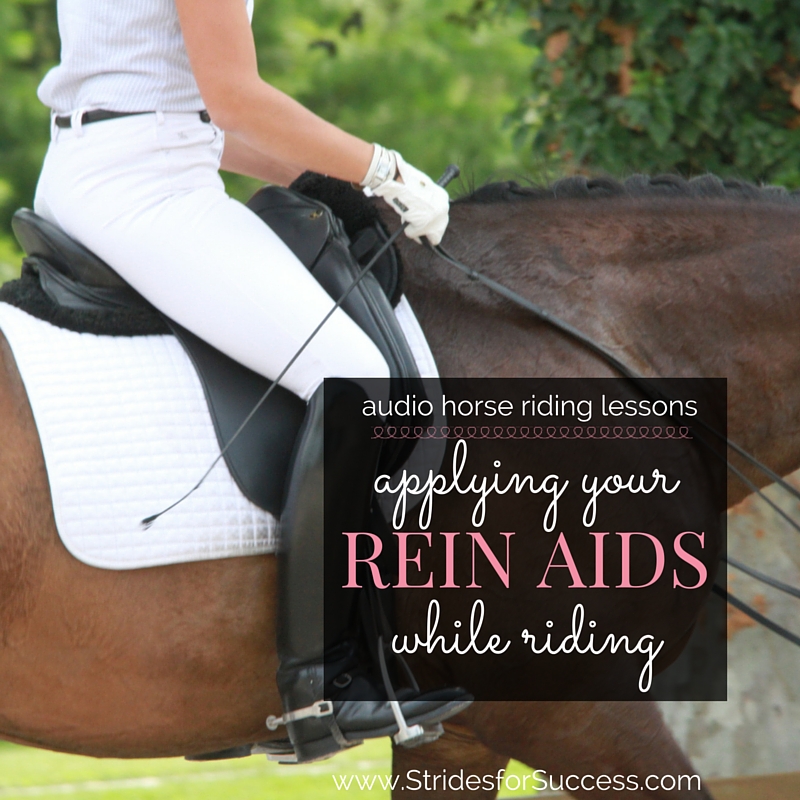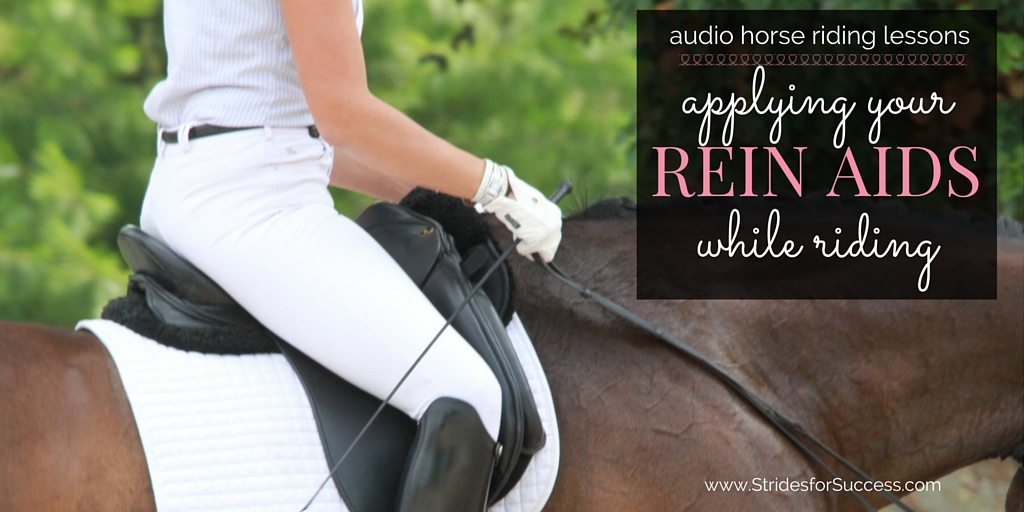.. This
Do you find yourself becoming confused and frustrated about how you are supposed to be using your rein aids while riding? Do terms such as soften your rein, fill up your rein, hold with the rein, lighten the rein leave you baffled? Not to mention how much pressure is good and how much is too much?!
I want you to take a quick trip down memory lane and back to your first ride on a horse… Chances are that back then, before you knew any different, you thought of your reins as the means to steer and stop your horse.
However, you soon began to realize that while your reins make up part of the system to do this, in order to really have a happy contact with your horse, you needed to reframe how you think of your reins. And what you use them for.

What are Rein Aids For?
Your reins are, first and foremost, the way that you collect the energy your horse creates in his hindquarters and back, so you can then channel it where you want it to go.
This is done through you have a consistent contact on the rein. This allows your horse to build trust in you that you won’t catch him or drop him while he is working into that contact.
However, before you can even begin thinking about this, we must first discuss how your hand will come to meet the rein and the effect this has on you and your horse.
An Extension of Your Core
While your hands are holding the actual reins, it is good to keep in mind that they are merely acting on behalf of your body.
This means that any aids happening through your core are connected to the conversation you are having with your horse down the rein with your hands.
A practical example of this is a pony trying to eat grass while being ridden. Riders that depend on the strength of their arms to apply rein aids will be pulled forward out of the saddle when the horse puts his head down. However, a rider that is connected through their seat and core, merely using their arms and hands as an extension of this, will sit tight as their core will come into play rather than their arms.
Your Hands and Arms
It amazes me that so many riders still believe they are strong enough through their arms to ‘win’ a pulling match against their horse. The sad part is that the pulling match should never happen to begin with.
Your hands have an important job of gathering up the energy created by your horse, however, this can only be achieved if your horse trusts your hands enough to connect that energy with them
Next time you are in the saddle, become aware of the fall of your arms as you ride. Is it a natural fall? Are you perhaps overarching your back? Is this resulting in your elbows being slightly behind your body? Or maybe you are collapsing your upper body causing your elbows to be in front of your body? How supple and flexible are your elbows?
Your arms should fall from your shoulders in a natural position.
Being supple and soft means that there will be little tension in them, just enough to carry your hands, which should be on a straight line between your elbow and your horse’s mouth along the rein. Your wrists should be straight, never clawed or bent. In fact, if you have to claw your wrist to ‘activate’ the rein, your reins are too long!
Your fingers and hands should also be soft and supple. Try not to clench your fingers into a fist. Rather use your thumb as a ‘clamp’ to hold the reins which will allow your fingers to follow and communicate with the rein and your horse’s mouth. Keep the pads of your finger tips as the touch point with the palm of your hand.
Suppleness Through Your Body
If your horse trusts you to be consistent and considerate with the rein, he will ‘seek’ the rein by moving his poll forward and down into the contact. A horse trying to evade or get away from a sharp hand will rather move his head up and back, causing his back to hollow.
Focus on keeping your hand and elbow supple and elastic. Move with your horse
So often horses that have been labeled as lazy or not very forward are this way because of a rider that failed to follow with their hand. Turning your knuckles on top, rather than your thumb, causes a similar scenario.
When you think of giving with your hand, think of allowing through your fingers first and then, if necessary through your elbows. It should be a slight, subtle communication with your horse. Work on how you can ‘allow’ using your fingers and next time you ride see if your horse responds to this more subtle direction.
The same applies when you think of taking or restraining; imagine moving the pads of your fingers closer to your wrist or ball of your thumb, gently closing your fingers rather than stiffening or clamping your fist.
Building Responsiveness
As you are practicing this, pay attention to how much pressure you are applying and how your horse responds. This can be a confusing principle for many riders. And it is often compounded by the fact that their horse may have already become a little hard or unfeeling through his mouth due to being ridden with hard hands before.
I suggest that rather than thinking about applying pressure, reframe that into what is necessary to ride your horse at that time in order to achieve or maintain the desired outcome. Then, over time, make adjustments and refine how you are applying the aid
The amount of pressure in your hand will directly correlate to how your horse is going. From the hindquarters through the back. And then resulting in where his head and neck are positioned due to this way of going.
Rein Aids & Self Carriage
The more true collection your horse has achieved, the lighter he will be in your hand. This is because he is now carrying himself. The result is that his poll having lifted up and is now situated closer to your hand. When working in a more relaxed outline, there will be a more consistent pressure.
Your job, as the rider, is to maintain that balance between your hand and your horse’s mouth through the rein.
However, if your horse is heavy on the forehand or leaning, you will feel a distinctly heavy and uncomfortable amount of pressure or weight down the rein. This is due to your ‘carrying’ him, rather than, as we just mentioned with the collection example, him carrying himself.
Consistent Contact (versus ‘Piano Fingers’)
The final point I want to talk about is ‘piano fingers’! Many riders think that by opening their fingers completely on the reins, they are somehow being nicer to their horse. Bear in mind that contact through the rein is a conversation. And conversations are a two-way street… Opening your fingers stops you from hold up your end of the chat! Rather work on being more supple and following through your hand, elbow and shoulder.
From there, when your horse learns to trust your contact, you can begin refining the pressure and movements in your communication.
I also feel it is important to note that this consideration of your horse’s mouth should colour all aspects of your time in the saddle. From gathering up the reins initially. To shortening and lengthening the reins (which we have a video on). And even to rewarding your horse by softening or giving with your inside rein.
Subtlety is the key to success where your horse’s mouth is concerned… Be gentle, soft and kind at all times.
Your Responsibility…
It is worth repeating again that in order for your horse to truly accept the contact you are providing down the rein, you must first guarantee him that you are going to provide a steady, soft, consistent contact to begin with.
And just like your horse having to strengthen himself in order to build up to a more collected way of going, you will too. This means finding ways to develop an independent seat. And practicing on making changes and adjustments gently and softly
Happy Riding
Lorna
Additional Resources for Equestrians:-
-
-
-
- Why Forward is Essential for Contact
- Retraining a Horse that Evades your contact
- Improving Your Riding Coordination & Aids While Lunging
- Join Connection today and transform your riding journey
- Lunging for Riding – 4-week step by step program to transform your lunging experience
- Online community for equestrians working on their mindset & fitness
- Online Community for equestrians focusing on re-schooling horses (and ex-racehorses)
- The Daily Strides Podcast on iTunes
- Daily Strides Podcast on Google Play
- The Daily Strides Podcast on Stitcher Radio
-
-

